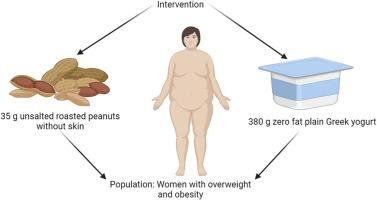Exploring the effects of high protein versus high fat snacks on satiety, gut hormones and insulin secretion in women with overweight and obesity: A randomized clinical trial
引用次数: 0
Abstract
Background
Nuts generally blunt the postprandial increases in glucose levels and increase satiety, while yogurt studies yield inconclusive results regarding post-meal hunger. This study investigated the effects of high-protein, and high-fat snacks, specifically Greek yogurt, and peanuts, on satiety, gut hormones, and insulin secretion in women with overweight and obesity. The hypothesis posited that peanuts would exhibit a more beneficial impact on satiety, gut hormones, and insulin levels compared to Greek yogurt.
Methods
The two-arm parallel randomized trial involved fifty participants aged 30–40 years with a BMI between 25 and 35 kg/m2, randomly divided into peanut (n = 25) and Greek yogurt (n = 25) groups. After three days of adhering to 1200 Kcal diet, appetite sensations were gauged using a visual analog scale (VAS) upon arrival, and at 30- and 60-min post-snack. Pre- and post-snacking, plasma levels of cholecystokinin (CCK), Peptide Tyrosine-Tyrosine (PYY), Glucagon Like Peptide-1 (GLP-1), Ghrelin (GHRL), and insulin were analyzed.
Results
Revealed that Greek yogurt induced a statistically significant increase in satiety 30 min after consumption and markedly elevated postprandial insulin levels compared to peanuts. Moreover, notable intergroup differences in postprandial insulin concentrations were observed in the Greek yogurt group. The peanut group had no significant alterations in PYY, GLP-1, CCK or GHRL levels. Pre-snacking, GHRL levels exhibited a positive association with abdominal circumference, weight, and fat mass, while CCK levels displayed a negative association with abdominal circumference, weight, and fat mass.
Conclusion
Greek yogurt may enhance satiety and thus has the potential to positively influence body weight in individuals with overweight and/or obesity. Further research is required to elucidate appetite control mechanisms.
Trial registration
The study was registered on ClinicalTrials.gov (No. NCT 04518930).

探索高蛋白和高脂肪零食对超重和肥胖女性饱腹感、肠道激素和胰岛素分泌的影响:一项随机临床试验
坚果通常会减缓餐后葡萄糖水平的升高,增加饱腹感,而酸奶研究对餐后饥饿感的影响尚无定论。这项研究调查了高蛋白和高脂肪零食,特别是希腊酸奶和花生,对超重和肥胖女性的饱腹感、肠道激素和胰岛素分泌的影响。该假说认为,与希腊酸奶相比,花生对饱腹感、肠道激素和胰岛素水平的影响更有益。方法采用两组平行随机试验,年龄30 ~ 40岁,BMI在25 ~ 35 kg/m2之间,随机分为花生组(n = 25)和希腊酸奶组(n = 25)。在坚持1200千卡的饮食三天后,在到达时以及在零食后30和60分钟使用视觉模拟量表(VAS)测量食欲感觉。分析进食前后血浆中胆囊收缩素(CCK)、肽酪氨酸-酪氨酸(PYY)、胰高血糖素样肽-1 (GLP-1)、胃饥饿素(GHRL)和胰岛素的水平。结果显示,与花生相比,希腊酸奶在食用30分钟后诱导饱腹感显著增加,餐后胰岛素水平显著升高。此外,在希腊酸奶组中观察到餐后胰岛素浓度的显著组间差异。花生组PYY、GLP-1、CCK和GHRL水平无明显变化。吃零食前,GHRL水平与腹围、体重和脂肪量呈正相关,而CCK水平与腹围、体重和脂肪量呈负相关。结论:希腊酸奶可以提高饱腹感,因此对超重和/或肥胖个体的体重有积极影响。需要进一步的研究来阐明食欲控制机制。试验注册:该研究已在ClinicalTrials.gov (No. 5)上注册。NCT 04518930)。
本文章由计算机程序翻译,如有差异,请以英文原文为准。
求助全文
约1分钟内获得全文
求助全文

 求助内容:
求助内容: 应助结果提醒方式:
应助结果提醒方式:


